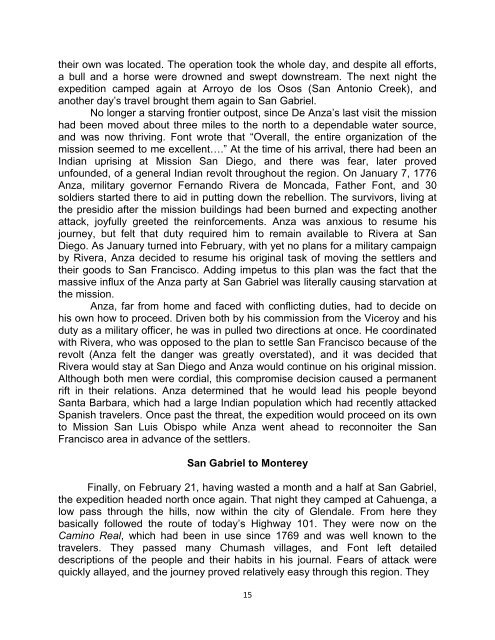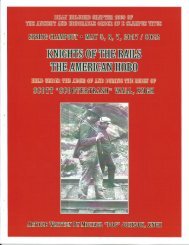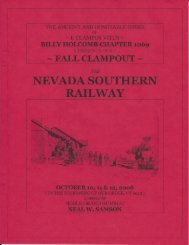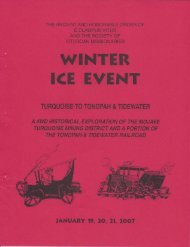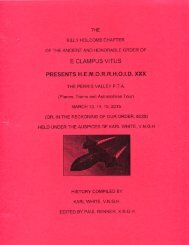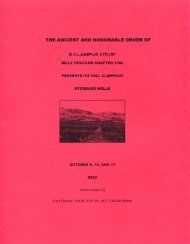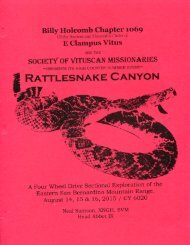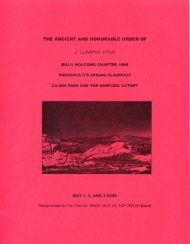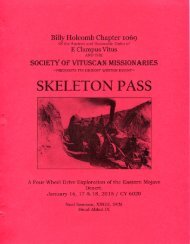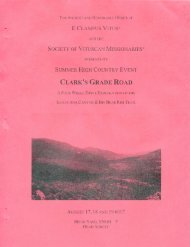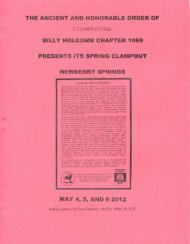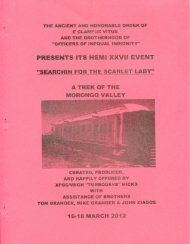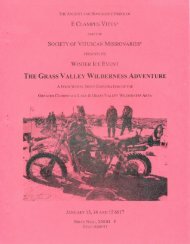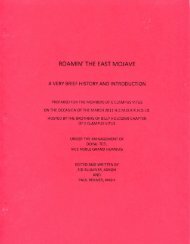6023 Spring Doins ANZA EXPEDITIONS History
Create successful ePaper yourself
Turn your PDF publications into a flip-book with our unique Google optimized e-Paper software.
their own was located. The operation took the whole day, and despite all efforts,<br />
a bull and a horse were drowned and swept downstream. The next night the<br />
expedition camped again at Arroyo de los Osos (San Antonio Creek), and<br />
another day’s travel brought them again to San Gabriel.<br />
No longer a starving frontier outpost, since De Anza’s last visit the mission<br />
had been moved about three miles to the north to a dependable water source,<br />
and was now thriving. Font wrote that “Overall, the entire organization of the<br />
mission seemed to me excellent….” At the time of his arrival, there had been an<br />
Indian uprising at Mission San Diego, and there was fear, later proved<br />
unfounded, of a general Indian revolt throughout the region. On January 7, 1776<br />
Anza, military governor Fernando Rivera de Moncada, Father Font, and 30<br />
soldiers started there to aid in putting down the rebellion. The survivors, living at<br />
the presidio after the mission buildings had been burned and expecting another<br />
attack, joyfully greeted the reinforcements. Anza was anxious to resume his<br />
journey, but felt that duty required him to remain available to Rivera at San<br />
Diego. As January turned into February, with yet no plans for a military campaign<br />
by Rivera, Anza decided to resume his original task of moving the settlers and<br />
their goods to San Francisco. Adding impetus to this plan was the fact that the<br />
massive influx of the Anza party at San Gabriel was literally causing starvation at<br />
the mission.<br />
Anza, far from home and faced with conflicting duties, had to decide on<br />
his own how to proceed. Driven both by his commission from the Viceroy and his<br />
duty as a military officer, he was in pulled two directions at once. He coordinated<br />
with Rivera, who was opposed to the plan to settle San Francisco because of the<br />
revolt (Anza felt the danger was greatly overstated), and it was decided that<br />
Rivera would stay at San Diego and Anza would continue on his original mission.<br />
Although both men were cordial, this compromise decision caused a permanent<br />
rift in their relations. Anza determined that he would lead his people beyond<br />
Santa Barbara, which had a large Indian population which had recently attacked<br />
Spanish travelers. Once past the threat, the expedition would proceed on its own<br />
to Mission San Luis Obispo while Anza went ahead to reconnoiter the San<br />
Francisco area in advance of the settlers.<br />
San Gabriel to Monterey<br />
Finally, on February 21, having wasted a month and a half at San Gabriel,<br />
the expedition headed north once again. That night they camped at Cahuenga, a<br />
low pass through the hills, now within the city of Glendale. From here they<br />
basically followed the route of today’s Highway 101. They were now on the<br />
Camino Real, which had been in use since 1769 and was well known to the<br />
travelers. They passed many Chumash villages, and Font left detailed<br />
descriptions of the people and their habits in his journal. Fears of attack were<br />
quickly allayed, and the journey proved relatively easy through this region. They<br />
15


